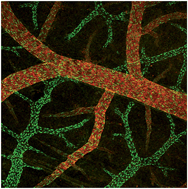Angiogenic effects of ionic dissolution products released from a boron-doped 45S5 bioactive glass
Abstract
In regenerative medicine of vascularized tissues, there is a great interest in the use of biomaterials that are able to stimulate angiogenesis, a process necessary for rapid revascularization to allow the transport and exchange of oxygen, nutrients, growth factors and cells that take part in tissue repair and/or regeneration. An increasing number of publications have shown that bioactive glasses stimulate angiogenesis. Because it has been established that boron (B) may play a role in angiogenesis, the aim of this study was to assess the in vivo angiogenic effects of the ionic dissolution products that from a bioactive glass (BG) in the 45S5 system doped with 2 wt% B2O3 (45S5.2B). The pro-angiogenic capacity of 45S5.2B BG was assessed on the vasculature of the embryonic quail chorioallantoic membrane (CAM). Ionic dissolution products from 45S5.2B BG increased angiogenesis. This is quantitatively evidenced by the greater expression of integrin αvβ3 and higher vascular density in the embryonic quail CAM. The response observed at 2 and 5 days post-treatment was equivalent to that achieved by applying 10 µg mL−1 of basic fibroblast growth factor. These results show that the ionic dissolution products released from the bioactive glass 45S5.2B stimulate angiogenesis in vivo. The effects observed are attributed to the presence the ionic dissolution products, which contained 160 ± 10 µM borate.


 Please wait while we load your content...
Please wait while we load your content...